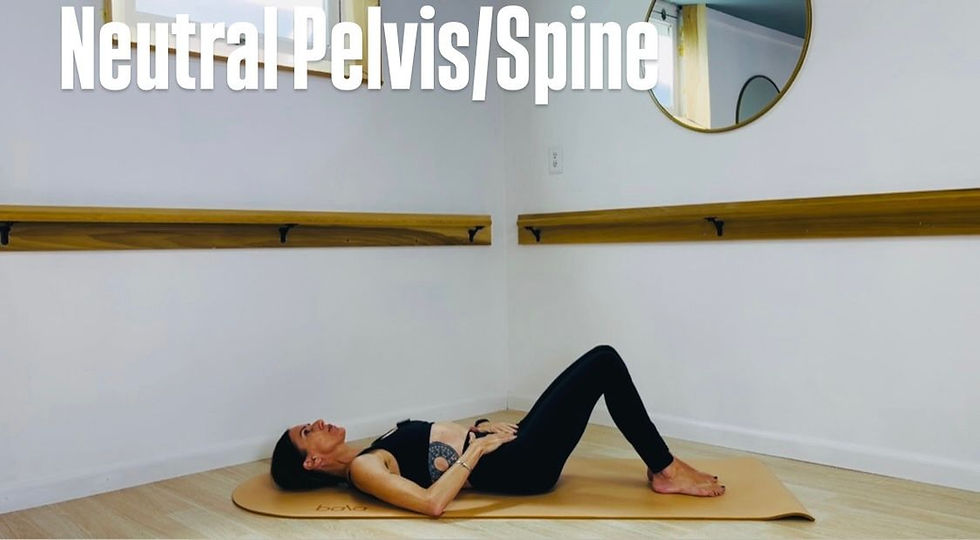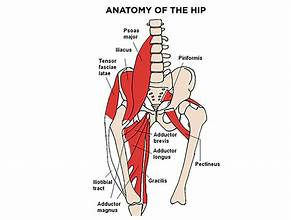Neutral Pelvis 101
- thegoodbarre

- Sep 3
- 4 min read

What is a neutral pelvis
A neutral pelvis is a balanced and natural alignment of the pelvic bones, situated midway between an excessive forward tilt (anterior tilt) and a backward tilt (posterior tilt). It is a foundational position for good posture, core engagement, and functional movement. Here's why it's important:
Natural spinal curves: When the pelvis is neutral, it supports the natural inward curve (lordosis) of the lower back, allowing the spine to maintain its proper shock-absorbing function.
Balanced alignment: In a standing position, the front of your hip bones and your pubic bone form a relatively vertical plane. When lying on your back, this plane should be horizontal or parallel to the floor.
Optimal core muscle function: This position allows your deep core muscles, including the transverse abdominis, pelvic floor, and multifidus, to engage and stabilize your torso effectively.
Minimal joint stress: A neutral pelvis reduces unnecessary strain on the lower back, hips, and knees by promoting a healthier distribution of weight and pressure.
How to find a neutral pelvis
A simple way to find your neutral pelvis is to feel the movement of your pelvis by rocking it back and forth. You can try this while standing or lying on your back.
Lying down
Lie on your back with knees bent and feet flat on the floor.
Imagine your pelvis is a bucket of water.
Anterior tilt: Tilt your hips forward, pouring the imaginary water toward your feet and increasing the arch in your lower back.
Posterior tilt: Tilt your hips back, pouring the water toward your chest and flattening your lower back against the floor.
Rock gently between these two movements until you find the midpoint where the "water" is level. This is your neutral pelvis.
Standing
Place your hands on your hips with your thumbs pointing to your back and fingers angling down over your pubic bone.
Your hands and fingers should be on a vertical plane and feel level.
Rock your hips forward and back until you find the middle ground where your hands are straight up and down.
Common neutral pelvis mistakes and how to fix them
Some common mistakes when trying to maintain a neutral pelvis during core exercises include arching the lower back, overusing the hip flexors, bracing the core too rigidly, and improper breathing. These errors can reduce the effectiveness of the exercise and may even lead to pain or injury.
Arching the lower back
The mistake: Allowing your lower back to arch excessively off the floor during exercises like dead bugs, leg lowers, and planks. This indicates that the deep abdominal muscles are not engaged, and the lower back and hip flexors are taking over.
The risk: This puts a lot of stress on the lumbar spine and can lead to lower back pain.
The fix: A simple trick is to place a rolled-up towel under the small of your back. You should maintain a consistent, slight pressure on the towel throughout the exercise. If you lose contact, it means your back is arching and you need to reset.
Overusing the hip flexors
The mistake: Feeling the exercise primarily in your hip flexors rather than your abdominals, especially during movements that involve lifting the legs, like dead bugs or leg raises. This happens when weak abdominal muscles cause the stronger hip flexors to compensate.
The risk: This can lead to tight, overactive hip flexors, which pulls the pelvis into an anterior tilt.
The fix: To isolate your abdominals, decrease your range of motion. For example, in a leg lower, do not extend your legs as far until you build the necessary core strength. You can also try dynamic warm-ups to release tight hip flexors before your workout, like glute bridges and foam rolling.
Rushing through movements
The mistake: Performing movements too quickly and relying on momentum, particularly in slow, controlled exercises like the dead bug.
The risk: Using momentum reduces core tension, diminishing the exercise's effectiveness and potentially leading to poor form, which increases the risk of injury.
The fix: Slow down and execute each repetition with control. Focus on stability and movement quality rather than speed or quantity. Your core should remain engaged throughout the entire movement, not just at the end.
Rounding the lower back (posterior pelvic tilt)
The mistake: When doing a plank, you might overly tuck your tailbone to flatten your back. This may temporarily increase abdominal engagement but can become a compensatory habit that hinders learning proper neutral spinal alignment.
The risk: This creates an incorrect movement pattern and can result in over-recruitment of the rectus abdominis, causing other essential core muscles to be underutilized.
The fix: Intentionally find a neutral pelvic position, midway between an anterior and posterior tilt. Concentrate on keeping the small, natural curve in your lower back while engaging your abs, instead of fully tucking your hips.
Check out the Beginner/Fundamentals channel in the online studio for tutorial videos. Please reach out if I can help you with anything.


